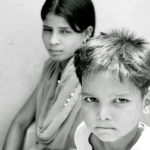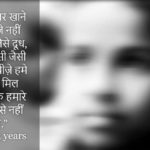In the span of the last one month, the burning issue of climate crisis has been brought to the notice of the masses by Greta Thunberg, a 16 year old teenager from Sweden. The fact that a school girl questioned the world leaders about their climate inaction caught the attention of people around the globe, and many people joined in with the movement led by her. Even though Greta’s feats deserve to be applauded, it is important to look at it through an intersectional lens, identifying the circumstances which enabled her to take such a huge step, and get the recognition she got in mainstream media at that age. Giving credit where it’s due, to mobilize millions of people around the world to fight for climate action, Greta Thunberg has done wonders. However, it is crucial to note that the mainstream media is infamous for highlighting work done by Caucasian people from a privileged background, pushing people from indigenous origins, as well as people of color, further into the periphery.
I write this blog to attempt to bring to the mainstream the many women from across the world that deserve the attention that Greta has been garnering over the last few weeks, not faulting her for her privilege, but the media for their marginalization of people from particular backgrounds. So, here are eight Women of Color climate activists you need to know about!
Autumn Peltier
Autumn Peltier from the Wikwemikong First Nations is a 15 year old climate activist and a “Water Warrior”. She began her advocacy for water at the age of 8, and has recently been named the Chief Water Commissioner of Anishinabek Nation, a position previously held by her great-aunt Josephine Mandamin. Autumn believes that water is essential, right from when we were fetuses in the womb, to our daily existence. Her traditional knowledge teaches her that water is sacred, thus it is the need of the hour to “warrior up” and take a stand for earth.
ArtemisaXakriabá
Artemisa Barbosa Ribeiro, known as ArtesmisaXakriabá since she belongs to the Xakriabá tribe in Minas Gerais, a south-eastern state of Brazil, is a 19 year old indigenous climate activist, who gained recognition during the Climate Summit on 23rd September, 2019. As a member of the Global Alliance of Territorial Communities, she marched in the first ever March for indigenous women, against the genocidal forest fire started by the President of Brazil. In her moving speech, Artemisa calls herself and other indigenous people the “children of Mother Earth”, who they are fighting for. Her main goal is to secure territorial rights for indigenous communities all over the world.
RidhimaPandey
An Indian girl of 11 years, RidhimaPandey is a Haridwar native who holds the government responsible for the current environmental crisis. In 2017, Ridhima filed a petition against the government to the National Green Tribunal, for their climate inaction, along with highlighting the increase in pollution in the country. She also strongly advocates for the ban on use of plastic.
HindouOumarou Ibrahim
Hailing from the PeuleMbororo pastoralist community of Chad, Africa, Ibrahim has been a first-hand witness to climate change. She is a strong advocator of the protection of indigenous people, along with providing them their rights. Ibrahim believes that climate change is a huge threat to indigenous people’s basic rights and to their culture, which revolves around natural resources. She especially highlights the vulnerability of women in such situations, because they’re the ones who provide food and water to their families. To give voice to the indigenous people, Ibrahim developed a 3D mapping system, which allows people to track and adapt to climate changes.
AmlaRuia
AmlaRuia, the founder of the Aakar Charitable Trust, has helped in building over 350 check dams impacting more than 400 villages in rural India. She has greatly involved the people of the communities in building these check dams through financial contributions, so that they take ownership of the infrastructure.Ruia has helped bring water to villages in not only her state of Rajasthan, but also to Madhya Pradesh, Uttar Pradesh, Orissa, Bihar, Haryana, and Maharashtra. The check damns have brought back prosperity to these villages; farms are flourishing with about three crops a year and women don’t have to walk long distances to look for water.
QuannahChasinghorse
QuannahChasinghorse from LakotaSioux Nations, Alaska, has always fought for protecting wildlife, especially since it is sacred and is considered to be a part of her community’s identity. When the President of the United States, Donald Trump, opened Arctic National Wildlife Refuge to oil drilling, Chasinghorse led a movement to protect the wildlife and the lives of many indigenous people. Following the movement, the US House of Representatives passed the Arctic Cultural and Coastal Plain Protection Act. QuannahChasinghorse also stands for Arctic communities being disproportionally affected by the rising temperatures of the earth.
Aneesa Khan
Aneesa Khan, a 23 year old from London, is the Executive Coordinator for SustainUs, and organisation formed by the youth for justice and sustainability. She saw the adverse affects of climate change as her family’s home was devastated in the floods that occurred in South India. Khan has been attending UN Climate Summits since 2014, and has always been perturbed by the world leaders talking about climate change instead of people like her whose future is at risk because of it. Through her organisation, Khan pushes for policies which are sustainable and gender just.
SaalumaradaThirumakka
SaalumaradaThirumakka is a 106 year old environmentalist from Karnataka who recently received the Padma Shri award from the President of India. In 80 years, Thirumakka has planted over 8,000 trees in her own village, Hulikal, and in surrounding villages. This started when Thirumakka and her husband decided to plant a row of trees on a 4 km stretch from her village to Kudoor, as there were no trees at all in the locality. Thus she was given the name Saalumarada, which means “a row of trees” in Kannada. Along with planting trees, Thirumakka has also worked on rainwater storage projects in her village, and has actively spread the message for afforestation.
References –
https://www.culturalsurvival.org/publications/cultural-survival-quarterly/hindou-oumarou-ibrahim-champion-indigenous-peoples-against
http://www.theweekendleader.com/Heroism/2830/water-idea.html





